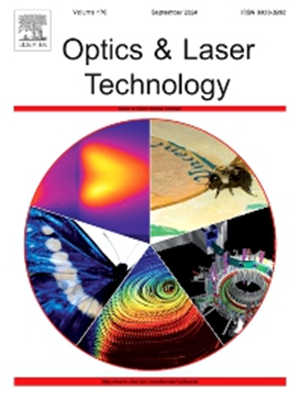Laser drilling of micro-holes with controllable taper using 355 nm nanosecond laser
IF 4.6
2区 物理与天体物理
Q1 OPTICS
引用次数: 0
Abstract
It is a great technical challenge to fabricate micro-holes in hard materials, such as tungsten and diamond, especially for controllable taper angle and low heat affected zone. In this paper, a simple method employing a 355 nm nanosecond laser, as well as a dual-path circular scanning strategy are presented to overcome these challenges. This method can adjust the angle between the laser beam and the rotation axis by altering the angle of the tilt stage, thereby enabling the controlled machining of micro-holes with tapers ranging from negative to positive. Additionally, comparative experiments with traditional circular scanning strategies have demonstrated that the dual-path circular scanning strategy effectively improves the roundness, drilling efficiency, and sidewall quality of micro-holes by expanding the ablation area. Using this method and strategy, micro-holes with tapers ranging from −14.9° to 23.8° were successfully fabricated in 300 μm-thick tungsten. Furthermore, they were employed to prepare a series of high-quality micro-holes on a typical nonmetallic high-hardness material, diamond.
使用 355 nm 纳秒激光钻出锥度可控的微孔
在钨和金刚石等硬质材料上制造微孔是一项巨大的技术挑战,尤其是在锥角可控和低热影响区方面。本文介绍了一种使用 355 纳米纳秒激光的简单方法,以及一种双路径环形扫描策略,以克服这些挑战。这种方法可以通过改变倾斜台的角度来调整激光束与旋转轴之间的角度,从而实现对具有从负锥度到正锥度的微孔的可控加工。此外,与传统圆扫描策略的对比实验表明,双路径圆扫描策略通过扩大烧蚀区域,有效提高了微孔的圆度、钻孔效率和侧壁质量。利用这种方法和策略,成功地在 300 μm 厚的钨中制造出了锥度为 -14.9° 至 23.8° 的微孔。此外,还在典型的非金属高硬度材料金刚石上制备了一系列高质量微孔。
本文章由计算机程序翻译,如有差异,请以英文原文为准。
求助全文
约1分钟内获得全文
求助全文
来源期刊
CiteScore
8.50
自引率
10.00%
发文量
1060
审稿时长
3.4 months
期刊介绍:
Optics & Laser Technology aims to provide a vehicle for the publication of a broad range of high quality research and review papers in those fields of scientific and engineering research appertaining to the development and application of the technology of optics and lasers. Papers describing original work in these areas are submitted to rigorous refereeing prior to acceptance for publication.
The scope of Optics & Laser Technology encompasses, but is not restricted to, the following areas:
•development in all types of lasers
•developments in optoelectronic devices and photonics
•developments in new photonics and optical concepts
•developments in conventional optics, optical instruments and components
•techniques of optical metrology, including interferometry and optical fibre sensors
•LIDAR and other non-contact optical measurement techniques, including optical methods in heat and fluid flow
•applications of lasers to materials processing, optical NDT display (including holography) and optical communication
•research and development in the field of laser safety including studies of hazards resulting from the applications of lasers (laser safety, hazards of laser fume)
•developments in optical computing and optical information processing
•developments in new optical materials
•developments in new optical characterization methods and techniques
•developments in quantum optics
•developments in light assisted micro and nanofabrication methods and techniques
•developments in nanophotonics and biophotonics
•developments in imaging processing and systems

 求助内容:
求助内容: 应助结果提醒方式:
应助结果提醒方式:


